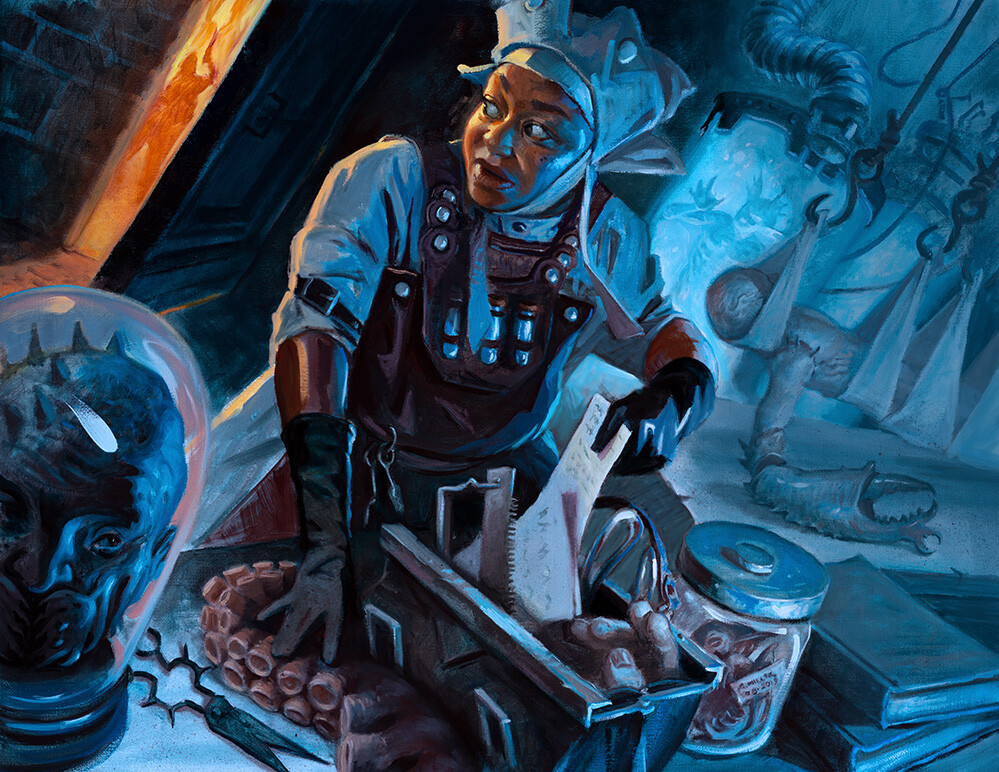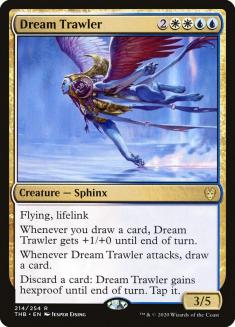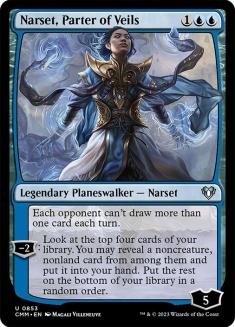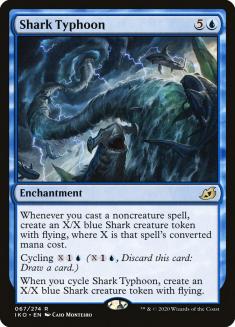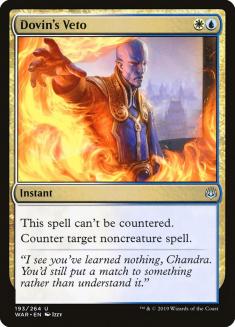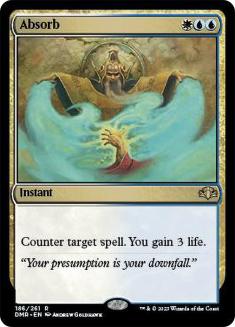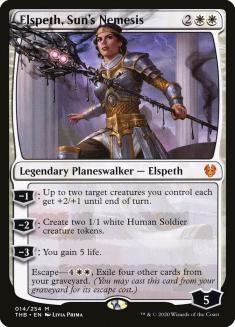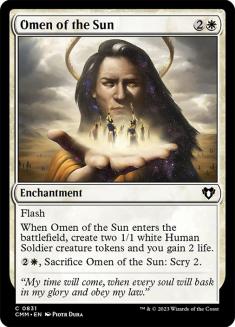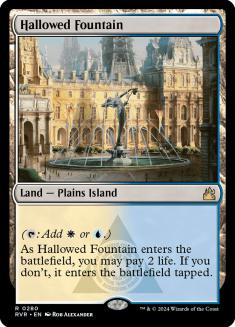After some heavy reflection and metagame analysis, it became abundantly clear that the current control decks are not up to the challenge in Core Set 2021 Standard. Temur Reclamation is so powerful that most resources must be dedicated to defeating it, leaving the aggro plan mediocre at best. Leaning heavily on Shatter the Sky is not a horrible plan, but there must be some support in the few turns prior.
Early removal can be a liability when the best deck in the format plays only a few targets. The early-game must prevent a Wilderness Reclamation from hitting the battlefield as well as provide guaranteed land drops. This seems easy enough with the high volume of counterspells and answers we have; however, those options perform very poorly against the various sacrifice and aggressive decks that still roam the top tier.
Bant Control tries to have it both ways, playing a few answers for Wilderness Reclamation, two copies of Shatter the Sky for aggro, and some powerful tap-out spells to apply pressure across the spectrum. Through rigorous testing, I have found that this type of control deck is in far too many lanes to be effective. The answer density in Bant Control is very low, due to the requisite spell suite that is required when playing Simic anything. Growth Spiral; Uro, Titan of Nature’s Wrath; Nissa, Who Shakes the World; and Hydroid Krasis are all automatically in the deck. Each card is powerful in a vacuum, but does not provide a concise answer to the top decks of the format. Speed, pressure, and win conditions are great; however, it is time for control to do what it does best — focus.
There are specific cards that indiscriminately handle business. These spells may be narrower, but the format is too dense and defined to handle the best decks with half-measures. Dream Trawler has fallen out of favor, which perplexes me. In most matchups out there, this resolved Sphinx is lights-out.
Against the most aggressive decks, it is obvious that Dream Trawler ends the game upon resolution. The hexproof and lifelink combined make it an impenetrable force.
The key trouble is the mana cost, making it much more difficult to resolve against the midrange, ramp, and control decks in the format. Against the slower decks, Dream Trawler must dodge Mystical Dispute, which is the argument often used against it.
This may be a bit of a news flash: every expensive control card suffers from this same fate. There is no way I stop playing sweet, expensive cards because a good counterspell for it is in the format. Once it resolves, Dream Trawler provides similar devastation to Bant Ramp, Temur Reclamation, and the control mirrors that have recently cut down on the sweepers.
It took me a few weeks to realize that the power level of Dream Trawler has not dropped, and the revelation hit when I continued to increase the number of matchups I sideboarded it in against. Once I realized that I want at least one floating around in there, it became the focal win condition for my control decks once again.
Dream Trawler is not the only specific answer that this Standard is vulnerable to. Narset, Parter of Veils is once against the second-best planeswalker in the format, joining Teferi, Time Raveler as a must-play. When two of the top three decks nearly fold to one that remains on the battlefield, it is time to run four copies in the maindeck. The restriction that Narset places on Bant Control and Temur Reclamation is astronomical and it has the power to consistently return to the battlefield with Elspeth Conquers Death.
All these cards exist in Bant Control in some fashion, but not with the staggering density that is required to defeat that type of mirror, Temur Reclamation, and any ramp strategy that lands on your desk. It’s time to return to a deck that can house all these format-stompers and has proven itself competitive.
Creatures (2)
Planeswalkers (8)
Lands (25)
Spells (25)

Azorius Control is back in business and better than ever. I, like many others, was lured by the green cards in error. Azorius Control never had a losing streak and was tossed aside as decks sometimes are. New best decks are discovered, additional sets throw a wrench in the natural order of the metagame, and people lose faith in the old answers for new threats. Elspeth Conquers Death, The Birth of Meletis, Dream Trawler, Teferi, Narset, Dovin’s Veto, and Absorb can still crush the competition when working together. The puzzle to solve is the quantity of each to defeat the current metagame and what new cards to incorporate.
Shark Typhoon is the best card in Ikoria: Lair of Behemoths and is the backbone of the new Azorius Control. The amount of angst I had when facing down a resolved Teferi was through the roof until this card arrived. I wrote love Tweets when Shark Typhoon was previewed, calling it easily one of the most powerful control spells printed in recent years. The evasion and size of the Shark, combined with its instant speed and card replacement, makes it a must-play in every blue deck moving forward.
I had a couple in Bant Control, but Azorius Control has the luxury of easily playing three or four copies. It takes some of the pressure off having to resolve a Dream Trawler or Elspeth Conquers Death against the decks with disruption, as well as providing a slam-dunk enchantment that wins the game on its own when the coast is clear.
I could write an additional article on the beauty of Shark Typhoon, but we still have Azorius Control to discuss.
Frantic Inventory is our Core Set 2021 addition and has injected pure adrenaline into the veins of Azorius Control. For the last few seasons, I have leaned heavily on card replacement and generic advantage from control spells to survive. True card draw has been a bust, not because the spells are weak, but there is simply no time to take advantage of them. I can’t take a turn off to draw a few cards, even though I could cast a Dig Through Time on Turn 4 at sorcery speed.
This all changed when Frantic Inventory was previewed. Even though this card has redefined how I view control card draw, it has not had room in control builds for adequate testing. Since Azorius Control is back on the table, it’s time to let Frantic Inventory shine.
Card draw being instant-speed and only two mana preserves entire turns. This is the way control turns played out when Think Twice was the Standard hotness and current Azorius Control has a similar feel. The big difference is that Frantic Inventory is way better than Think Twice and buries the opponent when additional copies are cast later in the game.
The early-game use provides land drops, while the late-game use provides the card advantage. At such a cheap mana cost with giant upside, Frantic Inventory will be another control staple in Standard for the next year. In the current metagame, it fits perfectly into a control shell that is half proactive and half reactive.
This is not your typical draw-go or tap-out control deck. Azorius Control is as much as a hybrid that I have seen, having a healthy sequence of both depending on the matchup.
Against Temur Reclamation, it is unlikely that you are dropping planeswalker after planeswalker due to their counterspells and the vulnerability they can easily expose when you are tapped out. The maindeck Dovin’s Veto, Absorb, and Frantic Inventory allow for you to dictate gameplay differently, especially in the sideboard games when additional countermagic is available.
The same can be said when attacking Bant Control or Bant Ramp, where tapping out can be detrimental. Against the aggressive decks, it is a series of tap-outs that wreak havoc on their battlefield and chances to develop an army early on.
You may notice the complete absence of Yorion, Sky Nomad. I have found that the 80-card drawback is negligible, except when running cards like Frantic Inventory and Shatter the Sky. It is a requirement, in some matchups, to clear the battlefield on Turn 4. Additional early cantrips can be played to assist that; however, I found it more effective to run a few copies of Time Wipe to makeup for the loss.
More expensive sweepers and less chance to find the best version are small sacrifices, but sacrifices to consistency, including the chance to hit multiples of Frantic Inventory, combine to create a weaker control recipe. If we were under the old companion rule, this conversation would not be occurring. With the new rule, this version of Azorius Control is a slam dunk on consistency, where the 80-card versions would fall short.
Paulo Vitor Damo da Rosa wrote a beautiful primer on his version of Azorius Control yesterday. While I may disagree with many elements of his deck, his premise is spot-on. He broke down the metagame win percentage, acknowledging his weakness to Temur Reclamation and Bant Control, but declaring victory over the remaining aggressive elements. I came to the exact same conclusion when beginning my Azorius Control journey, but I cannot accept being weak against the top two decks without a fight. Starting with Yorion, I began shaving pieces of the deck that did not help against the top two decks. These pieces were not only weak against Temur Reclamation and Bant Control, they were also nothing to write home about against the rest of the field.
Without Yorion, a card like Omen of the Sun is unplayable. Even with the companion, making some Soldier tokens won’to create the desired impact. Like every other control player, I wanted Elspeth, Sun’s Nemesis to be good, but it is not. Making a bunch of Soldiers and coming back from the dead to do it again was not enough to make it a staple of control decks.
Providing early blockers and pressure from an Omen of the Sun sounds good in theory, but it falls short in nearly every way possible. Cards in the final stages of an old Standard must provide big against the best decks, making Omen of the Sun an easy cut from the control roster.
One of the biggest challenges Paulo’s Azorius Control deck has is the ratio of counterspells to other spells in the sideboarded games. After multiple iterations, twelve counterspells in a 60-card deck, fueled by the power of Frantic Inventory, has been enough to keep problematic cards off the battlefield.
When two of the three best decks can be held at bay by dedicating a few extra slots to them, it is well worth it. The aggro matchup has not deteriorated from the changes, which is the true test when tinkering with control matchups. If the concessions to aggressive decks do not result in losses and just make the games tougher to win, those are effective modifications.
Overall, I think Paulo’s version of Azorius Control has some heavy hitters, but Yorion is not worth the cost. Playing it as a companion, as well as including the other three copies in the maindeck, pushes the deckbuilder to maximize copies of Omen of the Sea and Omen of the Sun, which is not the best direction to move toward in the current Standard.
Frantic Inventory outperforms Omen of the Sea, Omen of the Sun is not a good card, and Yorion is a weak win condition in comparison to Dream Trawler. At relatively the same casting cost risk, Dream Trawler is the clear centerpiece for Azorius Control in this current field. However, in the same, correct premise as Paulo’s, it is important for Azorius Control to remain dominant against the last third of the field, which both versions do.

